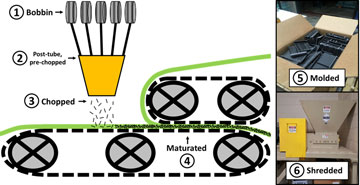Article contents
Degradation of E-glass fiber mechanical properties during composite sheet molding compound production for automotive applications
Published online by Cambridge University Press: 06 November 2019
Abstract

Research into pyrolysis-based recycling of sheet molding compounds (SMCs) to recover glass fiber for reuse has indicated significant pre-existing tensile strength damage in the shredded recycling input materials. This loss in mechanical durability inherently hurts the value proposition of recycled glass fiber by limiting reuse of the fiber for reinforcement. In this study, the mechanical properties of glass fibers at each step in the first lifecycle of an SMC material are measured to assess the extent of cumulating fiber damage prior to recycling and identify potential causes of this degradation to maximum fiber tensile performance.
- Type
- Research Letters
- Information
- Copyright
- Copyright © Materials Research Society 2019
Footnotes
This manuscript has been authored by UT-Battelle, LLC under Contract No. DE-AC05-00OR22725 with the U.S. Department of Energy. The United States Government retains and the publisher, by accepting the article for publication, acknowledges that the United States Government retains a non-exclusive, paid-up, irrevocable, worldwide license to publish or reproduce the published form of this manuscript, or allow others to do so, for United States Government purposes. The U.S. Department of Energy (DOE) will provide public access to these results of federally sponsored research in accordance with the DOE Public Access Plan (http://energy.gov/downloads/doe-public-access-plan). The information, data, or work presented here was funded in part by the Office of Energy Efficiency and Renewable Energy (EERE), the U.S. Department of Energy, under Award No. DE-EE0006926. The information, data, or work presented here was funded in part by an agency of the United States Government. Neither the United States Government nor any agency thereof, nor any of their employees, makes any warranty, express or implied, or assumes any legal liability or responsibility for the accuracy, completeness, or usefulness of any information, apparatus, product, or process disclosed, or represents that its use would not infringe privately owned rights. Reference here to any specific commercial product, process, or service by trade name, trademark, manufacturer, or otherwise does not necessarily constitute or imply its endorsement, recommendation, or favoring by the United States Government or any agency thereof. The views and opinions of the authors expressed here do not necessarily state or reflect those of the United States Government or any agency thereof.
References
- 1
- Cited by



